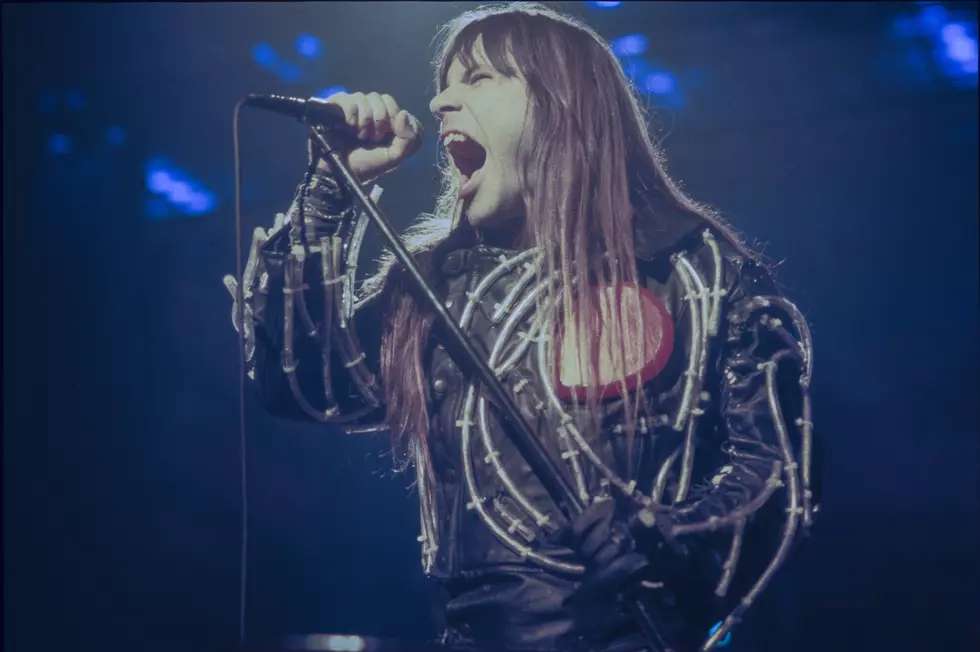
When Iron Maiden Started a New Chapter With ‘The X Factor’
Iron Maiden officially turned the page on perhaps the most glorious chapter of their career on Oct. 2, 1995, sketching out a brand new one with The X Factor. This was their 10th overall album but the first recording with new singer Blaze Bayley, who was trying to fill the rather large shoes vacated by his predecessor Bruce Dickinson.
Today, the very prospect of replacing Dickinson (who returned to the band in 2000) seems almost preposterous and doomed to fail, so why did they even bother trying? Well, what most people seem to forget is that Iron Maiden leader Steve Harris had faced this singer-swapping dilemma once before before, just over a decade earlier, when he brought in Dickinson to replace his band’s first singer, Paul Di'Anno. That worked out pretty well.
So, who could blame Harris for assuming it would also work for Bayley, who arrived into the Maiden fold just brimming with the energy of youth, fresh blood, and quite a respectable CV fronting the once highly touted Wolfsbane for several years. As history soon showed, Blaze would not prove equal to the daunting task of matching Dickinson’s amazing achievements.
But then, it’s doubtful anyone else could have measured up, because Iron Maiden were facing issues at the time that had absolutely nothing to do with their young frontman. These ranged from the uncertain future facing all heavy metal bands due to the commercial peak of grunge to the retirement of longtime Iron Maiden producer Martin Birch, which forced Harris to produce The X Factor himself with help from engineer Nigel Green. In addition, the bassist was in the middle of going through a traumatic divorce.
So this was the convoluted backdrop upon which Iron Maiden — then completed by drummer Nicko McBrain and guitarists Dave Murray and Janick Gers (himself still trying to fully replace the departed Adrian Smith and his sizable songwriting contributions) — convened at Harris’ own Barnyard Studios, in Essex, England, to marshal their talents into The X Factor. And, though they managed to complete no less than 14 songs (three of which were used as b-sides), these generally reflected all of the band's non-musical concerns via some of the darkest, most pessimistic numbers Iron Maiden ever put to tape.
Also some of the most challenging, musically speaking — namely where the 11-minute introductory epic, “The Sign of the Cross,” was concerned, as well as prog-leaning offerings like “Fortunes of War,” “The Unbeliever,” the melancholy “The Aftermath,” and the positively morbid “Blood on the World’s Hands.” Even when the group displayed a little more self-editing discipline, backed up by clear-cut chorus sections on “Lord of the Flies," “Look for the Truth,” the blistering "Man on the Edge,” and the semi-anthemic "Judgement of Heaven" these were almost always overwhelmed by its creators' exceedingly worried, all-too-serious outlook and dour subject matter.
As for Bayley, whether it was because of Harris’ inexperience taking charge behind the mixing board or the near-impossible feat of matching Dickinson’s air-raid siren power, his vocals often finished last in a race to keep up with the instruments being wielded with such confidence and finesse by his older, more experienced bandmates. Finally, at the end of the day, there was just a generalized lack of energy emanating from The X Factor's leaden tempos and palpable depression.
All of which ensured a very tepid critical and popular reception to the album upon its highly anticipated release that fall, with chart positions significantly lower than Iron Maiden were accustomed to in most every country: No. 8 in Britain, No. 17 in Japan, and comparable declines beyond that. Even worse, the album barely scraped the U.S. chart at a deplorable No. 147, and forced Iron Maiden to scale back their touring ambitions to playing theaters, instead of arenas, for the first time in a decade. But of course the band made the best of their predicament with their usual professionalism and determination, by touring across the farthest reaches of the globe, where their services were still welcomed enthusiastically.
What choice did they have? With Dickinson committed to his solo career (and struggling as much as his old bandmates to make a go of it), there would be no chance for a reunion between all parties until another Bayley-fronted LP, 1998's Virtual XI, was released to even greater indifference, and helped set the wheels in motion for Blaze's inevitable scapegoating and the triumphant return of Dickinson and Smith for 2000's Brave New World. But one should not dismiss the Bayley era out of hand, because it was thanks to his participation, the band's persistence, and albums like The X-Factor, imperfect as they might have been, that the road back to glory was even there to be taken, later.
Top 50 Classic Heavy Metal Albums
More From Ultimate Classic Rock









